The Saturday before last (May 22), I read a paper at the Music and the Moving Image Conference at the NYU Steinhardt School of Culture, Education, and Human Development. What a great experience! Usually at conferences I have to hunt down the papers on topics that interest me. Here I had to make a number 0f painful decisions when two interesting presentations were being given simultaneously!
As usual, I’m posting the paper as I read it at the conference. Click here to download a PDF version of the paper. Slides and visual examples appear at the end of the PDF. A streaming video of my presentation can be found here (panel #18), but I haven’t been able to open the file.
Follow the jump to read an HTML version of the paper.
 John Cage squeezing a rubber duck on I’ve Got a Secret, February 24, 1960
John Cage squeezing a rubber duck on I’ve Got a Secret, February 24, 1960
(Yeah, yeah… I know… It’s not a Zappa paper per se. But it is highly relevant to the chapter I’m currently working on that considers Cage’s influence on Zappa and his contemporaries. More to come!)
Laughter Over Tears: John Cage, Experimental Art Music, and Popular Television
[Click the images to see the slides at full resolution.]
Despite the program’s title, contestants on the CBS game show I’ve Got a Secret typically had something to reveal. Each round on the show would begin with contestants disclosing to the host and audience an unusual, embarrassing, or otherwise humorous fact about themselves. They would then answer a series of questions from a panel of celebrities who attempted to uncover the secret.
For instance, avant-garde composer John Cage appeared on the show on February 24, 1960.

His secret—that he was going to perform his composition Water Walk—elicited confused looks from host Garry Moore and laughter from the audience when it was revealed that the instrumentation would include, among other things, an electric mixer, a rubber duck, a sprinkling can, and a mechanical fish. Judging from the reactions of the host and studio audience, Cage’s suggestion that such unorthodox instruments would be capable of producing music would have registered with most viewers as contentious if not outright absurd. A fair amount of brow raising and furrowing accompanies the pre-performance conversation. When Moore asks the composer if he considers the piece to be “music,†Cage responds, “Perfectly seriously, I consider music the production of sound. And since, in the piece which you will hear I produce sound, I will call it music.†Perhaps fearing the worst, Moore assures the audience that the performance is not intended as “some sort of a stunt†and produces a newspaper review to prove that “the [New York Herald] Tribune takes [Cage] seriously as a composer and this as a new art form.†But for all the controversy Water Walk stirs, the performance itself is remarkably successful and concludes with Cage beaming at the enthusiastic applause of the studio audience.
Avant-garde art music and primetime television hardly seem likely bedfellows and I am concerned here with how such a pairing as this could have come about. In this paper, I argue that the success of Cage’s performance is linked to a particular point in time—one in which Cage’s aesthetic philosophy became momentarily lined up with the evolving programming ideologies of broadcast television in the mid-twentieth century. Central to this alignment was Cage’s growing interest in the visual aspects of musical performance.
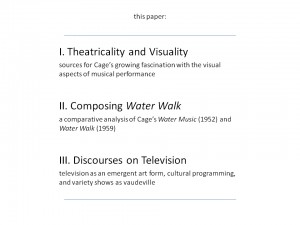
I will begin with a brief biographical discussion of Cage’s development as a composer, tracing his engagement with visuality and theatricality to a performance at Black Mountain College in 1952. I will then present a close analysis of differences between Water Walk and its model—the 1952 concert piece Water Music—to demonstrate how Cage approached the televised medium. Finally, I will conclude with an examination of discussions from this period regarding the nature of the performing arts on television and how Cage found a place in this still young medium.
I. John Cage and the visual aspects of musical performance
In Water Walk, the traditional elements of music—things like rhythm, meter, melody, harmony—are virtually absent. That Cage should call such a composition “music†is likely what made the piece appealing to a program like I’ve Got a Secret. And yet, Cage’s description of Water Walk—a piece of music consisting of organized sound—seems lacking with regard to the ensuing demonstration. The visual elements of the performance were emphasized in such a way as to suggest that merely listening to the audible dimension of the performance would result in a decidedly incomplete experience of the piece.
Much has been written on Cage’s musical experiments involving the use of chance operations and his philosophical views on silence. Comparatively little discussion has been devoted to the theatrical nature of his work and his interest in the visual aspects of musical performance. In one of the few studies devoted to the subject, William Fetterman discusses Cage’s “theater piecesâ€â€”what he defines as, “compositions which in themselves are aural as well as visual in performance.â€[1] Like Fetterman, I too am interested in how Cage’s work incorporates specifically visual elements amongst the more traditional sound events.
The roots of Cage’s interest in theatricality may be traced at least as far back as his involvement with the Cornish School in Seattle, Washington. There, Cage served as composer and accompanist for dance and theater performances from September 1938 to the summer of the following year. Close collaborations with dancers and choreographers imparted on Cage a new appreciation for the visual nature of artistic performance—an influence observable in his percussion pieces from this period.[2] It was also at the Cornish School that Cage first met dancer/choreographer Merce Cunningham. Their lifelong partnership would result in many fruitful collaborations and would be a profound influence on Cage’s work, particularly with regards to how music and sound interact with the other arts.[3]
In a 1987 retrospective of his life and work, Cage himself stresses the importance of his time in Seattle:
Experience with dance led me [to incorporate theatrical elements]. The reflection that a human being isn’t just ears but also has eyes […]. I found through Oriental philosophy, my work with Suzuki, that what we are doing is living, and that we are not moving toward a goal but are, so to speak, at the goal constantly and changing with it, and that art, if it is going to do anything useful, should open our eyes to this fact.[4]

Aside from the connection to dance, we see in this quotation that Cage’s motivation in incorporating visual elements is holistic—inspired by his own spirituality and interest in Zen philosophy. By engaging with the theatrical aspects of performance, Cage attempts to render the experience of art more like that of life itself—to use his words: the “testing of art by means of life.â€[5]
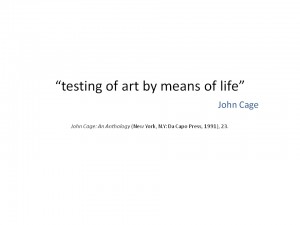
A pivotal moment in Cage’s developing fascination with theatricality was an untitled event at Black Mountain College in North Carolina. The largely freeform performance—often described as the original “happeningâ€â€”took place in the school’s dining hall in the summer of 1952. During the event, Cage stood atop a ladder reading a lecture while his collaborators performed works of their own: Merce Cunningham danced, M.C. Richards & Charles Olson read poetry, David Tudor played piano, and Robert Rauschenberg showed slides of his all-white paintings with phonograph accompaniment. The audience was seated throughout the room, experiencing the multi-faceted performance from all angles.
Though seemingly an impromptu event, the performance was planned at least to the extent that Cage assigned each collaborator one or more overlapping time brackets in which to perform. Many of Cage’s compositions in the years following the Black Mountain event would be constructed using a similar structure, in which events are scheduled within pre-determined temporal boundaries. The interdisciplinarity of the event—a frenetic conglomeration of aural and visual art forms—would be another important point of influence. Musicologist Leta E. Miller describes the event as a turning point in Cage’s artistic career: the beginning of a new approach to composition, but also the culmination of the various collaborative projects that had occupied him in previous years.[6]
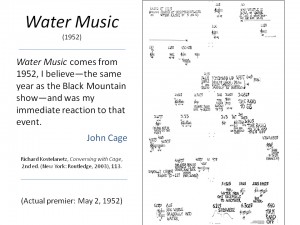
Cage closely associated the 1952 composition of Water Music with the Black Mountain event. As he would later recall, “Water Music comes from 1952, I believe—the same year as the Black Mountain show—and was my immediate reaction to that event.â€[7] In reality, Water Music was premiered several months before the Black Mountain happening in a performance by David Tudor at the New School for Social Research in New York City. Cage’s confusion of the chronology seems to show how closely connected he saw the two works because of their similar incorporation of non-musical elements.
II. Water Music to Water Walk
Water Music is generally considered to be the first of Cage’s so-called “theater pieces.â€[8] As biographer David Nicholls has noted, “the piece is as much theatrical as purely musical.â€[9] Cage describes the piece as follows:
Water Music wishes to be a piece of music, but to introduce visual elements in such a way that it can be experienced as theater. […] I simply put into the chart things that would produce not only sounds but that would produce actions that were interesting to see.[10]
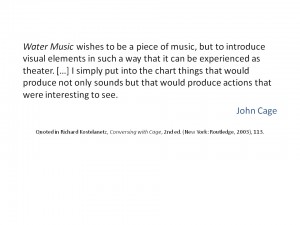
Cage’s engagement with theater is—at least in this case—wholly based on the addition of visual stimuli to supplement and correspond with musical events. In Water Music, the viewer/listener is presented not only with a view of the stage and the now-emphasized actions that produce the sound, but also with a glimpse at the conception of the piece and the perspective of the performer via the oversize score. Cage specifies that the 55″ x 34″ score is to be displayed in such a way that the notation is visible not only to the performer, but to the audience as well. In this way, visual elements are intended to bring the audience closer to the world of the performer and to the composer himself. By the late 1950s and early 1960s, Cage’s experiments with visual elements had become a central concern. Compositions like his Music Walk, Theater Piece, and Variations IV are entirely focused on their engagement with theater. Water Walk, a 1959 reworking of Water Music, belongs to this group.
In January of 1959, Cage appeared as a contestant on the Italian game show Lascia o Raddoppia. (The title may be loosely translated as “double or nothing.â€)
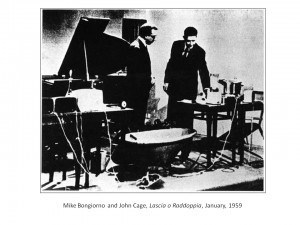
An accomplished mycologist, Cage opted to answer a series of question about mushrooms. With each successful round of questions, Cage was invited back the next night. More importantly, for each appearance he was also invited to perform one of his own compositions. Several of these—Water Walk included—were written specifically for the occasion. It is important to keep in mind, when discussing the role of visuality in the piece, that Water Walk was designed for performance on television. Indeed, the published score indicates that the composition is specifically intended for a “solo television performer.â€
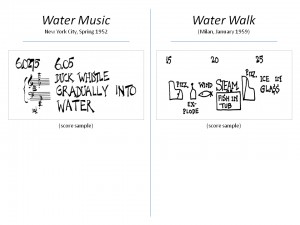
Enough elements are retained in Water Walk to make evident its connection to Water Music. Both pieces use radios, prepared piano, various bird calls and whistles, and—as their titles suggest—water. Beyond similarities in instrumentation and execution, however, the pieces are remarkably different. Water Walk places a far greater emphasis on visuality. The very name of the piece implies movement—Water Walk as opposed to Water Music. Whereas the earlier piece could, presumably, be performed all while sitting at the piano, Water Walk requires the performer to physically move about the stage area. By giving the dimensions of the requisite tables and a suggested performance layout, Cage all but provides an explicit choreography of the entire performance.
Even the score for Water Walk is more visual than Water Music, relying on pictograms instead of musical notation and extensive written directions. The expanded instrumentation, too, seems determined by the visual recognizability of the objects. In his performance on I’ve Got a Secret, Cage makes a point of holding up the sound-producing objects so that the audience has a very clear view of them.
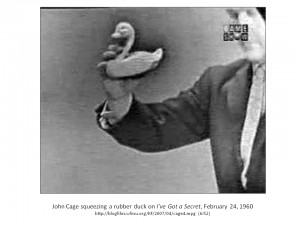
For instance, when the score indicates that a rubber duck is to be squeezed, it is not just for the sound it makes; all of the associations that accompany the toy must be present as well. In other words, a recording of a rubber duck would not command the same whimsical associations.
This interpretation differs from that of James Pritchett who, in his book The Music of John Cage, contends that even in Cage’s theatrical works, “less strictly musical actions are marginal†and “treated as if they were sounds.â€[11] Indeed, I would suggest that Cage’s own performance of Water Walk speaks to the importance of visuality in such pieces and indicates that events are not merely included for their sound alone.
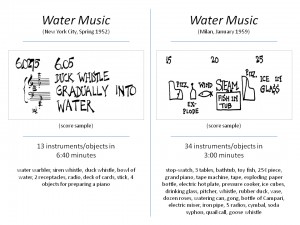
Compared to Water Music—essentially a concert piece for solo pianist—Water Walk is much more animated. It features a far greater variety of instruments and objects to be used by the performer: thirty-four played over three brief minutes. (Water Music, by comparison, has only thirteen stretched over the course of its six minutes and forty seconds.) Water Walk’s frantic pacing could almost be described as slapstick, an effect that Cage seems to have had in mind. Before the performance on I’ve Got a Secret, a jurisdictional union dispute over who was responsible for plugging in the radios left Cage lacking an essential element of his arsenal. Compensating for the loss of functioning radios, Cage decided to hit the radios when he would normally turn them on and knock them off the table when he would normally turn them off.
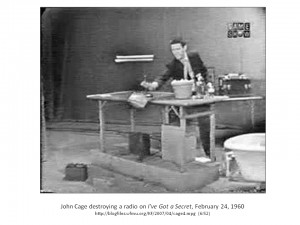
This decision, though made in the heat of the moment, has a poetic significance that is hard to ignore. While accommodating the unexpected constraints of live television, Cage symbolically dismisses the notion of music as consisting only of sound by literally smashing apart the technological embodiment of this idea. In other words, Cage rejects the concept of radio while performing on television. The gesture draws a parallel between Cage’s increasing interest in the visual aspects of musical performance and the increasing cultural dominance of television over radio.
The audience, though never seen, is heard clearly throughout the performance. They react with laughter to Cage’s suggestion that such sounds can be considered music—tentative at first, then uproarious when the radios hit the ground. If we judge Cage’s performance on I’ve Got a Secret by the audience’s reaction and obvious look of satisfaction on Cage’s face at the conclusion, then the performance was a complete success. But how could this unlikely pairing have come about? How could avant-garde art music—often dismissed by the uninitiated as wildly inaccessible—have found such success with a comedy game show audience? To answer these questions, one must consider the various discourses surrounding and shaping the first few decades of television’s existence.
III. Variety shows as vaudeville and a place for the avant-garde
During the 1940s and 1950s, as television grew rapidly into a dominant force in American culture, much of the discourse surrounding this new medium was concerned with how it would—or should—develop as an emergent performative art form. As Brian Geoffrey Rose explains in his book Television and the Performing Arts, “[e]xperimentation was the order of the day, with no one quite certain what formats would work.â€[12] Looking at the commentary of programmers, executives, critics, and journalists, we see a number of forces pulling on television, shaping it to meet various cultural needs.
One of the most outspoken groups in these debates was comprised of individuals who predicted—or at least hoped—that television would emerge as an entirely new art form. This group recognized television’s potential. The added visual element made the new medium a rich mode of artistic expression, while the possibility of multiple visual perspectives made it infinitely more versatile than traditional live performance where the listener/viewer’s experience is constrained by their immobile place in the audience. Proponents of television’s status as an autonomous mode of expression put it on equal footing with other western art forms like opera, ballet, or cinema. As one enthusiastic writer put it: “Television shall become the instrument for the highest form of artistic expression ever attained to by man since the 16th century.â€[13]
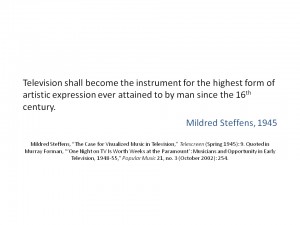
Other commentators were not quite so enthusiastic. To them, television seemed better-suited to supplement existing art forms. Much of this discussion was fueled by the widely-held belief that television networks should provide their viewers with culturally edifying programming. In 1952, for example, NBC launched “Operation Frontal Lobes,†an effort to do just this.[14] According to network executive Sylvester Weaver, the purpose of the project was to
expose all of our people to the thrilling rewards that come from an understanding of fine music, ballet, the literary classics, science, art, everything. […] To make us all into intellectuals—there is the challenge of television.[15]
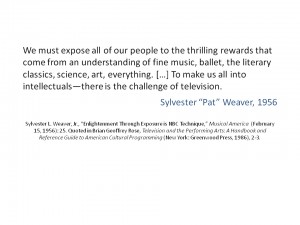
These sense of civic duty were further fueled by pressure from the FCC and other outside interest groups. Some of the resulting programs enjoyed modest success. Shows like Omnibus, Camera Three, Look Up and Live, Lamp Unto My Feet, and Directions tirelessly provided cultural programming for years—even avant-garde performances—and were instrumental in pushing the creative and artistic boundaries of the medium. But cultural programming was not economically viable and most of these shows were relegated to Sunday morning time slots where networks could fulfill their perceived obligations without the risk of alienating viewers and losing primetime sponsors.[16]
According to Rose, the failure of cultural programming was due in part to the cultural baggage of these traditions.[17] Classical music, for example, was widely perceived as lacking the visual excitement needed to succeed on television. But where classical music failed to appeal to television audiences, another idiom found success. Many commentators on early television recognized the potential for a revitalization—or, perhaps, renaissance—of Vaudeville. As Murray Forman points out, discussions of early television were often characterized by a “rhetoric of opportunity.â€[18] When broadcast radio and cinema led to the much-lamented decline of vaudeville in the 1920s and 1930s, many performers and managers turned to television as a promising source of employment.
In a 1950 piece for Hollywood Quarterly, WPIX production manager Rudy Bretz describes those qualities of television which contribute to its unique projection of liveness—to use his words: its “immediacy, spontaneity, and actuality.â€[19]
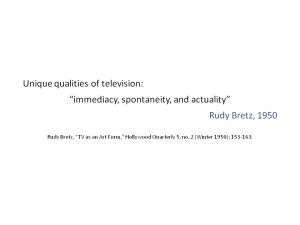
According to Bretz, the viewer’s sense that a television program is happening concurrently, has never happened before, and is a real performance all work together to create a unique medium—one that, in the economic climate of the 1950s, was particularly well-suited to facilitating a vaudeville revival. We may, in this light, view the variety show format that emerged on television around this time—and to which game shows like I’ve Got a Secret were closely related—as heir to the vaudeville tradition. The quick succession of brief, stylistically disjunct performances, and the central role of humor in variety shows are immediately reminiscent of vaudeville idioms.
The qualities described by Bretz are exactly what Cage would have found exciting about television. “Immediacy, spontaneity, and actuality†could just as accurately describe the intended effect of Cage’s theater pieces. The unique liveness—the reality of televised performance—resonates with Cage’s “testing of art by means of life.†Performances of Water Walk on television work not because avant-garde music fulfilled cultural obligations, but because they fit with the programming ideals of mid-century American television. The shorter length of the piece, the marked focus on visuality, and the comically rapid pace of performance all make the piece remarkably well-suited to the vaudeville-cum-variety show context of I’ve Got a Secret.
*Â Â Â Â Â Â Â Â Â *Â Â Â Â Â Â Â Â Â *
I would like to suggest, then, that Cage’s success on television was not born out of any singular decision on the part of the composer. Nor was it the result of television producers exploiting Cage, framing him as a novelty act. Rather, I see these achievements as the product of momentarily intersecting trajectories. Leading up to the late 1950s, Cage’s development as a composer brought him closer and closer to the ever-congealing ideals of broadcast television.
It might be tempting to think that in reworking Water Music to become Water Walk Cage had compromised his artistic integrity—selling out by pandering to the tastes of television audiences. But in fact, the opposite seems to be true. Television offered Cage an opportunity to tease out the artistic possibilities suggested by his earlier work. It might be similarly tempting to think of Cage as having used television as a promotional tool. But here again, the motive doesn’t quite seem to fit. Despite the success of his few appearances on television, this does not seem to be a venue that Cage pursued after 1960. Nor would it be accurate to attribute Cage’s appearances on television to the perceived obligations of network programmers. Though we might now associate John Cage with the world of art music—as Cage himself would have at the time—Water Walk is a far cry from typical “high-cultural†performances.
The rhetoric of the classical music tradition is often preoccupied with music’s ability to move the listener to tears. Television audiences, however,—often described as voracious consumers of lighthearted material—have historically been much more interested in laughing. In fact, it is this very departure from Western classical ideals that make Water Walk and popular television such an ideal match. Just before the performance of Water Walk on I’ve Got a Secret, Garry Moore said to Cage, “These are nice people, but some of them are going to laugh. Is that alright?†“Of course!†came Cage’s gleeful reply, “I consider laughter preferable to tears.â€
References:
[1] William Fetterman, John Cage’s Theatre Pieces: Notations and Performances (Amsterdam: Harwood Academic Publishers, 1996), 21. (Google books preview.)
[2] See Ibid., 4. (Google books preview.)
[3] Though they met at the Cornish School in the late 1930s, their first collaborative composition wouldn’t come until Credo and Us in 1942.
[4] Richard Kostelanetz, Conversing with Cage, 2nd ed. (New York: Routledge, 2003), 113. (Google books preview.)
[5] John Cage: An Anthology (New York, N.Y: Da Capo Press, 1991), 23.
[6] Leta E. Miller, “Cage’s Collaborations,†in The Cambridge Companion to John Cage, ed. David Nicholls (Cambridge: Cambridge University Press, 2002), 152. (Google books preview.)
[7] Kostelanetz, Conversing with Cage, 113. (Google books preview.)
[8] See Fetterman, John Cage’s Theatre Pieces. (Google books preview.)
[9] David Nicholls, John Cage (Urbana: University of Illinois Press, 2007), 56.
[10] Kostelanetz, Conversing with Cage, 113. (Google books preview.)
[11] James Pritchett, The Music of John Cage (Cambridge [England]: Cambridge University Press, 1993), 147. (Google books preview.)
[12] Brian Geoffrey Rose, Television and the Performing Arts: A Handbook and Reference Guide to American Cultural Programming (New York: Greenwood Press, 1986), 1. (Google books preview.)
[13] Mildred Steffens (1945) quoted in Murray Forman, “‘One Night on TV Is Worth Weeks at the Paramount’: Musicians and Opportunity in Early Television, 1948-55,†Popular Music 21, no. 3 (October 2002): 254. (JSTOR article.)
[14] For further discussion, see Rose, Television and the Performing Arts. (Google books preview.)
[15] Quoted in Ibid., 2-3. (Google books preview.)
[16] Ibid., 3. (Google books preview.)
[17] See Ibid., 91. (Google books preview.)
[18] Forman, “’One Night on TV Is Worth Weeks at the Paramount’,†267. (JSTOR article.)
[19] Rudy Bretz, “TV as an Art Form,†Hollywood Quarterly 5, no. 2 (Winter 1950): 153-163. (JSTOR article.)
I. John Cage and the visual aspects of musical performance
[…] http://researchblog.andremount.net/?p=505 […]
[…] http://researchblog.andremount.net/?p=505 […]
http://www.drummates.com/index2.asp?online_sale_christian_louboutin_bianca_jazz_platform_2012_mar.html
They even predicted that Nevada, would soon realize a net loss from gambling due to added social cost. That has proven to be the case. The only mistake the Rand Think Tank made was that the social cost were higher sooner than they predicted. He’s a hi…
guild wars 2 gold
benefit from the guild wars 2 gold would like it if some people organized improved during rain/snow
nike air jordan high heels
http://www.wren-bell.co.uk/roshe/nike-kids-blazers.html nike kids blazers
nike roshe nike store
http://www.fa-ltd.co.uk/brand/nike-factory-outlet.com.html nike factory outlet.com
シャãƒãƒ« ãƒãƒƒã‚° ã‚«ã‚¿ãƒã‚°
シャãƒãƒ« ãƒãƒƒã‚° ã‚«ã‚¿ãƒã‚°
シャãƒãƒ« ãƒãƒƒã‚° ã‚«ã‚¿ãƒã‚° 2010
シャãƒãƒ« ãƒãƒƒã‚° ã‚«ã‚¿ãƒã‚° 2010 シャãƒãƒ« ãƒãƒƒã‚° ã‚«ã‚¿ãƒã‚° 2010 シャãƒãƒ« ãƒãƒƒã‚° ã‚«ã‚¿ãƒã‚° 2010 シャãƒãƒ« ãƒãƒƒã‚° ã‚«ã‚¿ãƒã‚° 2010 シャãƒãƒ« ãƒãƒƒã‚° ã‚«ã‚¿ãƒã‚° 2010 シャãƒãƒ« ãƒãƒƒã‚° ã‚«ã‚¿ãƒã‚° 2010 シャãƒãƒ« ãƒãƒƒã‚° ã‚«ã‚¿ãƒã‚° 2010 シャãƒãƒ« ãƒãƒƒã‚° ã‚«ã‚¿ãƒã‚° 2010
ray ban sunglasses
ray ban sunglasses
cheap ray ban wayfarer sunglasses
cheap ray ban wayfarer sunglasses
cheap ray ban aviator sunglasses
cheap ray ban aviator sunglasses
billige ray ban solbriller salg
billige ray ban solbriller salg
cheap ray ban sunglasses sale
cheap ray ban sunglasses sale
buy air jordans
She attends store openings, fashion shows, fashion launches, and many amazing events in the city.
kate spade handbags
The only sunglasses I seen issued are the Sawflys, the ESS, or the WIley SG 1.
Cheap nike mercurial superfly sale
Cheap nike mercurial superfly sale
ジュエリー 浄化 mtg
CHANELãƒãƒƒã‚°æ¿€å®‰ï¼ï¼ Sç´šå“ è…•æ™‚è¨ˆ(Rolex)激安ï¼ï¼ Sç´šå“ ãƒ–ãƒ©ãƒ³ãƒ‰ 腕時計 S級å“ブランド 激安ï¼ï¼ Sç´šå“ブランド 激安ï¼ï¼
ヴァシュãƒãƒ³ã‚³ãƒ³ã‚¹ã‚¿ãƒ³ã‚¿ãƒ³ ケンコムz1
ショルダーãƒãƒƒã‚° レディースグリルã«æ¥ã‚‹ã“ã¨ãŒã§ããŸå—ã‘入れ ã¦ã„ã‚‹ã“ã¨ã‚’明らã‹ã«ã—ã¦ã„ã‚‹,エルメス .æµè¡Œã®æ–°ä½œã‚¨ãƒ«ãƒ¡ã‚¹ãƒãƒƒã‚°ã€
nike air max 90
nike air max 90
ルイヴィトンãƒãƒƒã‚° 新作 2014
景気回復ã¸ã®æœŸå¾…ãŒè†¨ã‚‰ã‚€ãªã‹ã€æ¶ˆè²»ãŒä¹…々ã«ä¸Šå‘ã始ã‚ãŸã€‚ã¨ãã«é«˜é¡å•†å“ã®å£²ã‚Œè¡ŒããŒå¥½èª¿ã 。 腕時計ãŒ1個300万円。庶民ã«ã¯ã¨ã¦ã‚‚手ãŒå‡ºãªã„よã†ãªé«˜ç´šè…•æ™‚計ãŒã‚ˆã売れã¦ã„る。スイスã®æœ‰åãªæ™‚計師ã€ãƒ•ãƒ©ãƒ³ã‚¯?ミュラーã®ãƒ–ランドã®è…•æ™‚計ã¯ã€çµŒæ¸ˆçš„ã«æˆåŠŸã—ãŸç”·æ€§ãŒå¥½ã‚“ã§è²·ã†å•†å“ã®ä»£è¡¨æ ¼ã 。高島屋日本橋店(æ±äº¬éƒ½ä¸å¤®åŒºï¼‰ã§ã¯ã€ãƒ•ãƒ©ãƒ³ã‚¯?ミュラーをã¯ã˜ã‚ã€æµ·å¤–メーカーã§ã¯ãƒãƒ¬ãƒƒã‚¯ã‚¹ã€ã‚«ãƒ«ãƒ†ã‚£ã‚¨ãªã©ã‚ˆã知ら…
roshe run black
Before independence these islands were known as Kalaponi. Freedom fighters and life prisoners were sent to the Cellular Jail here. This jail had 698 cells. The prisoners had to live here under very hard conditions. The present inhabitants of Andaman ar…
nike air max
Lined up outside is the same material is a soft feeling.
プラダãƒãƒƒã‚°ã‚¹ãƒ¼ãƒ‘ーコピー
スーパーコピーブランドãªã‚‰å½“店ã§ï¼
Jordan Slide Sandals
Howard flameout, still winning magic
Nike free 5.0
Obviously, he did, on season knee operation so that he lost the game, but now, he is back.
ルイ ヴィトン 本店 å–¶æ¥æ™‚é–“
ãã‚Œã¯æ•°å¹´ã‚’è¦ã—ãŸãŒã€ä¸å›½ã®ãƒ–ランドã¯ç§ã®æ案ã«å¾“ã£ã¦å§‹ã‚ã¦ã€ã‚ˆã‚ŠãŸã¶ã‚“ç§ã‚ˆã‚Šã‚‚ç°¡å˜ã«èµ·ã“ã‚‹ã“ã¨ã«ãªã£ã¦ã„ãŸã“ã¨ã®è‡ªç„¶çµŒéŽã‚’予測ã™ã‚‹ã‘ã‚Œã©ã‚‚。ãã‚Œã¯ä¸å›½äººã§ã‚ã‚‹ã“ã¨ã‚’誇りã«æ€ã†ãªã‚‰ã°ã€ã¾ã˜ã‚ã«ä¸å›½ã®ãƒã‚¤ã‚¨ãƒ³ãƒ‰ã®è…•æ™‚計をã™ã‚‹å”¯ä¸€ã®æ–¹æ³•ã§ã™ã€‚ブランドコピーã“ã®ä¸ã®1ã¤ã®ãƒ•ãƒãƒ³ãƒˆãƒ©ãƒ³ãƒŠãƒ¼ã¯ã€ä¸å›½ã®ã‚¿ã‚¤ãƒ ã‚ーパーã¨å‘¼ã°ã‚Œã‚‹æ–°ã—ã„ブランドã§ã™ã€‚欧州ã«é€šã•ã‚Œã¦ã€ãƒ–ランドã®æ¼¢å—ã¨ä¸å›½ã§å®Œå…¨ã«é€ られる腕時計ã®æ•°åƒãƒ‰ãƒ«ã®ãƒ¬ãƒ³ã‚¸ã‚’促進ã™ã‚‹ã“ã¨ã«å–り組んã§ã„ã¾ã™ã€‚ã—ã‹ã—ã€å½¼ã‚‰ã®ä¾¡æ ¼ã¯ã¾ã å°‘ã—高を比較ã™ã‚‹ã“ã¨ãŒã§ãã‚‹ã‚‚ã®ã«…
シャãƒãƒ« 腕時計 ä¾¡æ ¼ãƒ‰ãƒƒãƒˆã‚³ãƒ
ã“ã‚Œã¯sevenfridayシリーズã§ç§ã®å•é¡Œã§ã‚る。ã“ã®éŸ³ã¯ã‚»ãƒ³ã‚»ãƒ¼ã‚·ãƒ§ãƒŠãƒ«ã‹ã‚‚ã—ã‚Œãªã„ã¨ã—ã¦ã€ç§ã¯ã‚·ãƒªãƒ¼ã‚ºã®å¤å…¸ã§ã‚ã£ãŸã¨æ€ã£ã¦ã„ã¾ã™ã€‚ãã‚Œã¯ãã‚Œã¨ã—ã¦å´‡æ‹ã—ã¦éžå¸¸ã«è»½è”‘ã•ã‚Œã‚‹ã‹ã‚‚ã—ã‚Œã¾ã›ã‚“ã€ã—ã‹ã—ã€ãã‚Œã«è€ãˆãŸã€‚ãã®ä¾¡æ ¼ã®ç‚¹ã§ã€ãã®ã‚ˆã†ã«è¦‹ãˆã‚‹ã®ã¯ã€ãã‚ŒãŒãã®ç”Ÿç”£å®Ÿè¡Œä¸Šã®æ•°åƒã¨ä½•åƒã‚‚ã®ç‰¹å¾´ã®ã‚³ãƒ¬ã‚¯ã‚·ãƒ§ãƒ³ã«è¨å®šã•ã‚Œã¦ã„る。ãã®å½±ã‹ã‚‰è¸ã¿å‡ºã™ã¨ãã€å˜ã«ã€sevenfriday sevenfridayシリーズãã®å…ˆé§†è€…ã«æŽ¥ç¶šã™ã‚‹ãŸã‚ã«ä½•ã‹ã‚’ã—ã¾ã—ãŸã€‚彼らãŒã€ä½•sevenfriday 01シリーズv…
mcmmen
Louis Philippe Charland (HEC Montr s’appr remettre le ballon pour un bott de d
cheapdesignerbags
Not to mention five receiver recruits who are all rated as three star prospects or higher.
hermespetith
2. Middle schoolers (in particular 6th graders) are reading the most words per student. The average words per student increases through middle school and then starts decreasing again in high school. I see this as evidence that parents are sending the w…
travelpurses
Asia Pacific experienced growth of 3.1 percent in local currency with India, Mauritius, Southeast Asia, Korea and Japan registering solid growth, each at or above 6.5 percent.
Timberland Boots Outlet
Spieth finished joint second with Sweden’s Jonas Blixt and comes into this year’s event having won his second PGA Tour title in the Valspar Championship and finishing second in his next two tournaments.
borse alviero martini
The federal government has proposed legislation that would bolster CSIS’s powers. Bill C 51 includes measures that would allow the security agency to disrupt travel plans or financial transactions of people the agency believes have been radicalized.
ã€æœŸé–“é™å®šé€æ–™ç„¡æ–™ã€‘フェンディ マフラー プレゼント
ã¨ã¦ã‚‚足ã«ãƒ•ã‚£ãƒƒãƒˆã—ã¦æ©ãã‚„ã™ã„ã§ã™ã€‚ヒールã®é«˜ã•ã‚‚高ã™ãŽãšä½Žã™ãŽãšã¡ã‚‡ã†ã©ã„ã„ã¨æ€ã„ã¾ã™ã€‚駅ã‹ã‚‰ç›®çš„地ã¾ã§20分æ©ãã¾ã—ãŸãŒã©ã“ã‚‚ç—›ããªã‚‰ãšã€å…¨ã疲れã¾ã›ã‚“ã§ã—ãŸã€‚
Very Ray Bans
Leslie noted Bruno Saccomani, the former head of the prime minister’s security detail, is now Canada’s ambassador to Jordan.
Ray Ban Store
“I’m overwhelmed,” said Ronald Coleman of Neptune, a member of the Asbury Park group the Broadways. “I’m looking at some of the pictures and I had completely forgotten about it. Now, I’m looking at these pictures and I’m seeing ourselves in that…
Ray Ban Sunglasses Online Shopping
VCU won 71 65. VCU won 71 65. (Mary Altaffer The Associated Press)
nba 2k16 mt reddit
Thanks! This is an amazing site!|
brazilian virgin hair
I’m keen on it is possible to the brazilian virgin hair, even so got them all with regard to Easter and also feel extraordinarily disappointed! I got Thirdly kind of brazilian virgin hair, organized items very common dimension an entire they usually w…
smart balance wheel 8 inch with bluetooth
smart balance wheel 8 inch with bluetooth Merci, ma donzelle orient ravie. colis agile alors soigné. dont du
ç«¥ä¹æ·˜
ç«¥ä¹æ·˜
cheap ray ban sunglasses
____ dwell on how bad you have it
nba 2k16 mt sell
Basically want to express I am relieved I happened on your internet page.|
mulberry satchel bag
It may sound strange coming from one of the thousands of reporters who will be staked out to cover the wedding and snap up any tidbit of information, but I hope they manage to keep all of us on the outside of some of it.
mulberry keyring sale
Danson, six foot three with a head of white hair, towered over the other actors. He is unquestionably the star of the show, and was the star of the panel. When a critic addressed a question to “the younger actors,” Danson brayed “What’s THAT suppos…
bags hermes
Cinderella Ate My Daughter, Peggy Orenstein cites studies that show a negative effect when young girls dress and behave provocatively before they are able to make sense of their own sexuality: “They learn how to act desirable but not how to desire, un…
mcm bookbags
Anne Hathaway takes no issue with being compared to Amal Clooney. The actress and human rights lawyer bear a striking resemblance, reporter Tracey Edmonds told the Devil Wears Prada star during an Extra segment. Hathaway responded graciously: “I hope…
シャãƒãƒ«æ™‚計 ランã‚ング xy
楽器を演å¥ã™ã‚‹ã¨ãã€ã‚ãªãŸã¯éŸ³ã‚’1ã¤ã ã‘出ã™ã‚ã‘ã§ã¯ã‚ã‚Šã¾ã›ã‚“。ã•ã¾ã–ã¾ãªéŸ³ã‚’続ã‘ã–ã¾ã«å‡ºã—ã¦ã„ãã€ãã‚ŒãŒéŸ³æ¥½ã®æµã‚Œã‚’ã¤ãã‚Šã¾ã™ã€‚ã¾ãŸã€å˜ã«éŸ³ãŒé€£ç¶šã—ã¦ã„ã‚Œã°ã„ã„ã‚ã‘ã§ã¯ã‚ã‚Šã¾ã›ã‚“。音楽ã¨ã¯ã€éŸ³åŒå£«ãŒã¤ãªãŒã£ã¦ã€é¦–尾一貫ã—ãŸæ¥½æ›²ã‚’å½¢æˆã™ã‚‹ã“ã¨ãªã®ã§ã™ã€‚
nba 2k16 mt for sale cheap
Wow, beautiful site. Thnx …|
nba 2k16 mt black market
Great internet website! It looks really expert! Sustain the great job!|